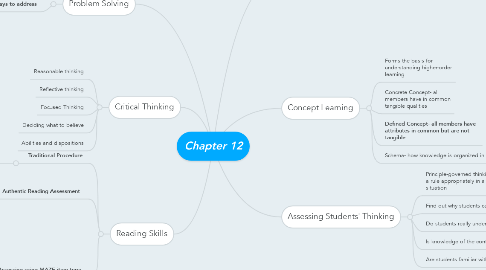Chapter 12
by Eric Tunney


1. Problem Solving
1.1. Different ways to address
1.1.1. General vs. Specific
1.1.2. Through the use of "IDEAL"
1.1.3. Through the use of Heuristics
2. Critical Thinking
2.1. Reasonable thinking
2.2. Reflective thinking
2.3. Focused Thinking
2.4. Deciding what to believe
2.5. Abilities and dispositions
3. Reading Skills
3.1. Traditional Procedure
3.1.1. Students read and answer questions
3.2. Authentic Reading Assessment
3.2.1. Use of appropriate passages
3.2.2. Use of multiple passages and viewpoints
3.2.3. Combing reading with writing and other exercises
3.3. Assessing using MAZE item type
3.3.1. Students can only answer items after reading the context
3.3.2. Students must construct meaning
3.3.3. Objectively scored
3.3.4. More focused answers
3.3.5. Students do not necessarily need much outside knowledge
4. Assessing Higher-Order Thinking
4.1. Context-dependent item sets: Create tasks that require knowledge and skill in new situations
4.1.1. Sometimes called "interpretive exercises"
4.1.2. Students process given information to answer questions
4.1.3. Can be used with any type of question
4.1.4. Ability to use: reference materials, graphs/tables, and maps in a useful manner
